| |
Initiating
urban water harvesting in Kenya
With the objective of broadening the prospect and outreach of the
Network for Green Water Harvesting in Eastern and Southern Africa,
a three member CSE team visited Kenya from August 25, 2003 to September
2, 2003. In collaboration with Regional Land and Water Management
Unit (RELMA), strategies were developed for institutionalising urban
rainwater harvesting campaign in Nairobi and Nakuru. Awareness generation
programmes were organised in these cities for diverse group of people
(academicians, researchers, architects, government officials, politicians,
industrialists, students, water experts, bi-lateral agencies, water
groups, interested citizens and local organisations).
Related links :
Meeting with the different
ministries
Seminar on urban rainwater harvesting
Establishing model projects in
Nairobi
Developing an urban rainwater harvesting
manual for Nairobi city
Understanding the process of women
led water harvesting initiaitve
Presentation on Urban Rainwater Harvesting
at Egerton University, Njoro
Public Lecture on Urban Water Supply
and Storm Water Management for local citizens
Experiencing Masai community's water
harvesting initiaitve
Meeting at UN Habitat
Workshop for Nairobi city counselors
and water works engineers
Output
Future action plan
| Date
|
Place
|
Details |
| 25.09.03 |
Nairobi |
1. Briefing at UN Habitat,
United Nations Office regarding CSE's campaign and the Green
Water Harvesting in Eastern and Southern Africa and South Asia
2. Discussion with Chin Ong, Acting Director at Regional
Land and Management Unit (RELMA)
3. Finalising the tour schedule along with the representatives
of RELMA and Kenya Rainwater Association (KRA) |
| 26.09.03 |
Nairobi |
1. Meeting at the ministry
of public works
2. Meeting at the ministry of water resource
3. Meeting at the ministry of agriculture
4. Meeting with the deputy mayor of Nairobi |
| 27.09.03 |
Nairobi |
1. Joint Seminar at RELMA
on Urban Rainwater Harvesting |
| 28.09.03 |
Nairobi |
1. Visit to the national
museums of Kenya to review the water harvesting initiative followed
by a meeting with Idle Omar Farah, Director General f National
Museums of Kenya
2. Steering the development of urban rainwater harvesting
manual along with the representatives of RELMA and KRA |
| 29.09.03 |
Nakuru |
1. Finalising the framework
for the urban rainwater harvesting manual
2. Villages visits to observe water initiatives by women's
group · Presentation at Egerton University, Njoro on
Indian urban rainwater harvesting experiences
3. Public Lecture on Urban Water Supply and Storm Water
Management for local citizens at Rift Valley Sports Club |
| 30.09.03 |
Masai
Mara |
1. Travel
from Nakuru to Masai Mara |
| 31.09.03 |
Masai
Mara |
1. Site
visit to observe the community oriented water works accomplished
by RELMA in Masai Mara |
| 01.10.03 |
Nairobi
|
1. Detailed
briefing of the UN Habitat team on CSE's campaign, experiences
of rainwater harvesting in India and Kenya
2.
Workshop for councilors of Nairobi city on urban rainwater harvesting |
| 02.09.03 |
Nairobi |
1. Wrap
up meeting with the RELMA representatives |
Meeting with the different ministries
On 26th August the CSE team along with representatives from RELMA
and KRA met the officials from
- Ministry of Public works
- Ministry of water resource development
- Ministry of Agriculture and
- The deputy mayor of Nairobi city
At the ministry of Agriculture the team met Kenneth O Ayuko, Director
of Agriculture and J K Kiar, Project Coordinator of National Agricultural
and Livestock Extension Programme (NALEEP). The discussion revolved
around the overall water scenario and food security in Kenya and
the experiences from India and contribution made by CSE's campaign
in streamlining the community-based water management systems as
a national agenda.
According to the officials agriculture sector's contributes is 20
- 30 per cent to the GDP. They have a total of 48 million hectares
of which only 20 per cent has been exploited. The reason for such
a gloomy scenario is the lack of technological development in the
area of water management.
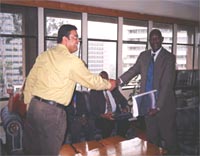 |
| Meeting
with Ministry of water resources |
Due to the political turbulence in Kenya not much thought was given
to develop and sustain the water sources. After Kibaki took over
as the President of Kenya, there has been a deliberate effort to
streamline and effectively manage the water sources in the country.
According to Ayuko, drafting of the water policy 2002 is an ideal
example.
The importance of rainwater harvesting in the rural areas of Kenya
is gaining momentum and presently the following strategies being
adopted to increase the agriculture production
- Roof catchment technology
- Road runoff catchment
- Water and farm ponds
- Sand and sub surface dams and
- Conservation tillage
While discussing the urban water scenario the officials were skeptical
about the present day systems and were of the opinion that rainwater
harvesting must be considered as the option to decrease the city's
dependence on rural areas and to create alternatives locally.
Later in the day the team met K G Chesang, SS Director of water
development, ministry of water resources management and development.
In the beginning the team briefed him about the green network as
well as the experiences of Jal Swaraj campaign. According to him
the enthusiasm of the minister Martha Karua is helping them to take
up certain bold steps. Secondly also due to the water sector in
Kenya being given the highest allocation in the annual budget. He
did acknowledge the importance of rainwater harvesting and clearly
mentioned that traditional practices were being sidelined to the
contemporary practices. He was of the opinion that the faith on
traditional systems needs to be restored. Ironically in the end
he did project his strong affiliation for major and medium water
projects.
In the evening the team met Lawrence G Ngacha, deputy mayor of
the city council Nairobi. During the meeting Ngacha was briefed
about
- CSE and its water campaign
- Green water network and
- Initiation of urban rainwater harvesting campaign
The meeting with the deputy mayor was extremely fruitful. On CSE
team's initiative that the deputy mayor agreed to organise a seminar
cum orientation programme for the city council's councillors and
water engineers. The mayor himself was extremely interested to know
more about the details and impact of urban rainwater harvesting
initiatives in India. According to him the increasing pressure on
urban centres has forced them to look at alternatives and urban
rainwater harvesting seems to be the need of the hour.

Seminar on urban rainwater harvesting
On 27th August a seminar was jointly organised by RELMA and
CSE at Lundgren hall in World Agroforestry Centre, Nairobi. Architects,
representatives from NGOs, Educational institutions, government
officials, researchers, journalists, and interested citizens from
Nairobi attended the seminar. Elijah K Biamah, Lecturer from Nairobi
University, inaugurated the seminar. The seminar was divided into
following sessions
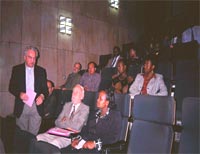 |
|
Presentation
at RELMA
|
Session 1 - Introductory
Session 2 - Experiences from India (Jal Swaraj campaign, Rainwater
Harvesting Techniques, Experience from water conscious city - Chennai,
Policies and Legislations)
Session 3 - Experiences from Kenya (KRA, International Water
Management Institute and University of Nairobi) and Wrap up session
Majority of the queries was related to the campaign, CSE's impact
on policy makers and recharge technique in urban rainwater harvesting.
In the concluding session the Ake Barklund, Director RELMA expressed
his concern that the African countries have to learn a lot, execute
and benefit from CSE's experience in achieving water security through
local intervention. He mentioned that unlike the general understanding,
urban rainwater harvesting has a direct linkage is making rural areas
water sufficient. According to him following are the water sources
for Nairobi city
- Kikuyu springs from 17 km
- Sasumua dam 70 km
- Ruiru dam 36 km
- Ndakaini/Thika dam (Ngethu water works) 50.7 km
Therefore Barklund was of the opinion that if Nairobi could harvest
water locally then the pressure on the adjoining rural areas would
lessen and the water instead of being diverted to the city can be
used for increased agricultural production.

Establishing model projects in Nairobi
The national Museums of Kenya has been responsible for introducing
the concept of rainwater harvesting in Nairobi city by executing
rainwater harvesting in the museum campus. In fact in May 2003 the
museum was able to partly solve the water problem of their employees
when the entire city was facing acute water crisis due to the bursting
of the pipeline from Sasumua dam. The employees were allowed to
take rainwater from the storage tanks to their houses for meeting
the domestic use. Otherwise people in Nairobi people were buying
water for 7,000 Kenya shillings for one tanker during the monsoons.
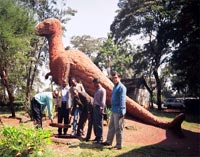 |
| Underground
storage tank |
RELMA designed the rainwater harvesting plan for the botanical
garden and the initial funding for the construction of three underground
tanks all of 105,000 litre capacity. The tanks received water from
the front portion of the roof of Mammal hall. Following this success,
RELMA upon request from the museums further facilitated the design
and installation of plastic lined of 30,000-litre capacity for the
reuse of water from the snake park which houses tropical snakes
tortoise and crocodiles.
After observing the water harvesting initiatives, the team met with
Idle Omar Farah, Director General NMK. The meeting was organised
to share with him the CSE's experiences - urban rainwater harvesting
in India and its strategies to make it a movement. During the meeting
CSE proposed the option of developing NMK as a model rainwater harvesting
project - first of its kind in Kenya. The DG did agree to the option
and also mentioned that they would be interested in harvesting the
entire rainwater falling on their campus.

Developing an urban rainwater harvesting
manual for Nairobi city
On 28th August CSE facilitated and steered the process of developing
a Nairobi specific manual on urban rainwater harvesting along with
representatives from RELMA and KRA. The group comprised of Eric Nissen-
ASAL Consultants Ltd, Alex R Oduor and Maimbo Malesu Peter Mwangi,
Kipmto Cherogony. During the two day session the following framework
of the manual was agreed upon
1. Introduction of the water scenario in Kenya
2. Nairobi specific water scenario
3. Status of water availability in Nairobi
4. Present water problems in Nairobi
5. Basic of rainwater harvesting along with case studies from Nairobi
6. Water management techniques
7. FAQs
Alex Oduor from RELMA has been made responsible for the compilation
and production of the urban rainwater harvesting manual. Once the
first draft is ready a copy will be sent to CSE for the editing
and layout. The remaining work of printing will be accomplished
at Nairobi.

Understanding the process of women led water
harvesting initiaitve
The visit to Elementaita village in Nakuru district of Kenya was
indeed a learning experience. Women of that area were able to solve
their drinking water problem through effectively harvesting rainwater
from their rooftops.
Initially women fetched water from a seasonal river - Kimmu that
was at a distance of 10 km from the village. They use to walk all
this distance to carry 20 litres of water. The source was being
used both by humans and livestock, therefore the quality was not
good. It had lot of biological contaminants, and it was muddy. On
assessing the deplorable water scenario the government agency constructed
borewells to source groundwater for domestic usage. Unfortunately
the borewells had fluoride content above permissible limit. The
fluoride content found in the groundwater was 12 to 14 mg/l. Due
to lack of other water sources, people were forced to consume the
fluoride rich water. As a result large population of people started
suffering from fluorosis. To minimise the adverse impact the government
agency installed a fluoride treatment plant in the village. As it
always happens the plant stopped working and people had to once
again depend on the borewell for water.
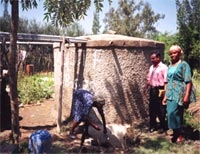 |
| Rainwater
storage tank |
At this stage Rotary International came to their rescue. Rotary
established Elementaita Rotary Community Corpse and this group was
responsible for implementing rainwater harvesting project. The project
entailed construction of rainwater storage tanks of 10,000 litres
with the help of community participation. The total cost of one
storage tank was 50,000 KSH. The cost of evenly shared between the
community and the club. The community contributed 24,000 KSH and
the remaining 26,000 was Rotary's contribution. Till now approximately
116 such storage tanks have been constructed. In order to eradicate
fluorosis Rotary has set a target of constructing 100 storage tanks
every year in the region. Along with water harvesting the women
group are also taking care of environment by plant trees under this
project.
The women groups from as far as 20 km had come to share their experiences
with the team. Most of the groups performed skits to highlight their
water woes and the impact of rooftop rainwater harvesting.

Presentation on Urban Rainwater Harvesting
at Egerton University, Njoro
Presentation by CSE on urban rainwater harvesting: experiences
and challenges was organised by the Egerton University, Njoro at
University Seminar Hall. P K Kiniani, Dean, Department of Engineering
and Technology chaired the session. Apart the lectures university
students actively participated in the workshop. The discussion after
the presentation mainly revolved around the feasibility and relevance
of groundwater recharge, ownership of water being recharged and
the role of university in improving the water scenario in the region.
Incidentally, the university has 16 borewells in the premises and
their entire water requirement is being met through groundwater
extraction. Presently, only 3 among the 16 borewells are working
and the rest of them have completely dried up. The water scenario
in the university was extremely upsetting
|
Demand
(2002)(m³/day)
|
Supply
(m³/day)
|
Deficiency
(m³/day)
|
|
2625
(2002)
|
1928
(2002)
|
697
(2002)
|
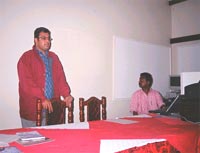 |
| Presentation
at Egerton University |
The university officials were excited once the CSE staffers shared
the experience of Jamia Hamdard University. According to the dean,
one has to start respecting rainwater otherwise the university night
have to face grave consequences. The university officials were also
briefed about the possibility of developing the university as a
model project for the other educational institutions to follow.

Public Lecture on Urban Water Supply and
Storm Water Management for local citizens
The public lecture was jointly organised by Nakuru chapter of KRA
and the Rotary Club at Rift Valley Sports Club. Industrialists, businesspersons,
academicians, government officials, and interested citizens of Nakuru
had attended the meeting. The presentation was divided into three
sections
- CSE's Jal Swaraj campaign
- Rainwater harvesting techniques in Delhi
- Potential of rainwater harvesting in Nakuru town
The industrialists were the most excited lot. Immediately after
the presentation, most of them wanted further clarification with
regard to the groundwater recharge as it was a new concept to the
people of Nakuru. The urban rainwater harvesting presentation at
Nakuru did trigger a sense of concern and interest amongst people.

Experiencing Masai community's water harvesting
initiaitve
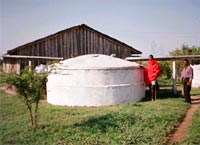 |
| Rainwater
storage tank at Masai Mara |
In Telak, a village bordering the Masai Mara wildlife reserve,
RELMA joined hands with a private company sharing the goal of improving
livelihoods for the community. One check dam, 23 water tanks, 5
community wells and a lot of know- how are the outcome of this collaboration.
By fitting gutters on the houses, it is easy to lead the rainwater
runoff from the roof into a water tank - and get good quality drinking
water. The owners of the house paid equivalents to two to three
cows, while RELMA trained the artisans who constructed the tanks.
Apart from this they have also constructed a infiltration gallery
from where the base camp gets the water. The community wells constructed
near the riverbed have solved the drinking problem, now people have
to travel only a few kilometers to get potable water instead of
the muddy river water.

Meeting at UN Habitat
The first meeting at UN Habitat was organised on 25th August with
Andre Dzikus, Human Settlement Officer, Infrastructure, Shelter Branch,
Global Division. The first meeting was a preliminary round of information
sharing. The second meeting was a comprehensive one attended by Kalyan
Ray, Coordinator, Water for African Cities programme and his team
members. The UN Habitat team was briefed on CSE's water campaign and
their strategies to deal with the urban manifestation of water woes.
As the meeting was organised at the end of the tour, the UN representatives
were also interested to know the team's understanding and experience
while dealing with the issue of urban water woes and rainwater harvesting
as a potential solution. After the first phase of the Water for African
Cities programme, the UN Habitat is looking at South Asia with special
focus on India to address the urban water issues. In India they are
concentrating on Bhopal and Indore.
The UN Habitat is keen to collaborate with CSE
- For capacity building on urban rainwater harvesting at the South
Asia level
- A joint parallel session and an exhibition on water at the Pan-African
Conference at Ethiopia in December

Workshop for Nairobi city counselors and water
works engineers
On 1st of September Lawrence G Ngacha, Deputy Mayor of Nairobi had
organised a workshop on urban rainwater harvesting with the city councillors
and water engineers headed by the general manager. The presentation
on Jal Swaraj campaign, urban rainwater harvesting technology and
experiences generated a lot of interest among the politicians and
professionals. After the presentation was over L M Musyoka, general
manager of Water works expressed the need for water harvesting in
solving the city water crisis. The Deputy Mayor shared similar thoughts.
According to him, Nairobi's over indulgence in water has resulted
into brewing conflict between them and the adjoining rural areas.
Therefore in order to restrain from such clashes the mayor reiterated
that Nairobi should consider options like rooftop rainwater harvesting
as an alternative of harvesting water locally. George E O Rarieya,
chairman, joint workers committee stressed the need for policy change
and incorporating rainwater harvesting as part of building by-laws.
The chairman also stressed the need of the having pilot projects or
model projects so that the people can easily comprehend the importance
of water harvesting.
In the end the workshop with the councillors was fruitful as it
helped them to realise the importance and potential of urban rainwater
harvesting in Nairobi's context. The Mayor did commit that he would
be happy to collaborate and work in tandem with RELMA and KRA

Output
- Initiated urban rainwater harvesting campaign at Nairobi and
Nakuru
- Developed the framework for Nairobi specific urban rainwater
harvesting manual
- Planned an internship training for two professionals from Kenya
on urban rainwater harvesting (New Delhi and Chennai)
- Identified model project in Nairobi and planned others in the
adjoining cities
- Planned Rain Centre either at Kenya, Tanzania or Ethiopia
- Finalised the India programme for the Southern and Eastern Africa
team
- Oriented politicians to introduce water legislations
- Planned out CSE's participation in the International exposition
being organised by the Kenya Rainwater Association on October
24th - 25th, 2003 at the National Museums of Kenya, Nairobi
- UN Habitat, Nairobi proposing to network with CSE through City
Foundation, New Delhi for capacity building at South Asia level
on urban rainwater harvesting
- Established RELMA as a clearing centre for CSE's publications
- Identified individuals and organisations associated with water
in Kenya

Future action plan
- Upscaling the campaign to other SEARNET countries like Tanzania,
Ethiopia, Uganda, Zambia etc
- Strengthening the urban rainwater harvesting campaign at Kenya
through setting up of model projects, miscellaneous services,
dossier on practitioners, developing city specific manuals
- Planning an East African visit by rural water warriors of South
Asia
|
|






